Wake Photography 101 part 2: Angles
Part 2 of the Wakeboarding Photography 101 article discusses different angles you can use to shoot wakeboarding and wakeskating.
Angles: The best way to get cool, different looking pictures is to get out of the boat and shoot from a different angle. Pros use a variety of different angles during photo shoots: from a tube, in a chase boat, from land, in a sitting duck position, from a helicopter; or, if none of these are options, just climbing up on the tower will provide a different angle than the straight, in-the-boat shot.
From the towboat: The most common place to take wakeboarding pictures is obviously the towboat. Many times, when you’re just hanging out for a day on the water with buddies it’s the only option. Here are some suggestions about how to get good-looking photos from the towboat.
1. If you’re worried about keeping the rider in focus, shoot from the center of the boat. Once you get the rider in focus you won’t have to change it again because the rider will always be the same distance from the camera. Now you can just worry about the light, framing the picture the way you want, and timing the action.
2. Remember, the focal length of your lens will affect the depth of field of a picture. When you’re shooting from the boat with a zoom lens, f2.8 creates too shallow a depth of field — only part of the rider will be sharp in the picture. Open your aperture up to f4 when shooting from the towboat, this way the rider will always be sharp, but the background will still be soft.
3. Mix it up. Don’t always shoot horizontally or vertically — use both. Use the rule of thirds in different ways. Zoom in really close to shoot tight and get the rider to fill up a good portion of the frame. A lot of dead space can kill a photo.
When shooting vertically from the towboat it is usually helpful to keep perspective of the water, especially when the rider is going huge. So try to keep the rider at the top of the frame, this way you’ll still see the water at the bottom of the frame. You’ll be keeping perspective of how big the rider is going, as well as using the rule of thirds by having the rider in the top third of the frame.
But don’t think that you can only get good pictures when a rider is in the air. Just because the subject isn’t doing a trick, doesn’t necessarily mean you can’t get a good photo. Always keep your camera up to your eye and follow the rider. When shooting from the towboat you don’t always have to have the rider riding directly into the sun to use the “golden hour” of light. Using sidelight can create a strong image, as well. Backlighting/silhouetting the rider can also be very cool from the towboat.
The key to getting good timing on action photographs is to pan your camera with the rider. Don’t hold the camera in one spot and wait for the rider to enter the frame before firing — that’s just dumb, and really hard. Pan with the rider and keep him/her in the part of the frame you want and then fire.
Remember, these are just suggestions for shooting from the boat. You don’t have to shoot tight or vertically or any specific way at all. Mix it up, try different things and see how the results turn out. Climb up on the tower and shoot from up there if you feel like it (make sure you’re the only boat on the water and the conditions are glass, first), or hang the camera off the side or back to get it low to the water. There are thousands of ways to take pictures from a inside the towboat alone, my biggest suggestion is to not get stuck doing it one specific way. Even if you think something might not look good, take it anyway and see.
From a chase boat: A chase boat/PWC is one of the most common ways for the pro photographers to shoot the riders. Chasing the rider from another vehicle is great because you can move to a variety of different angles and really play with framing/composition and lighting. Just be sure that your chase boat driver knows the sport well and that you are not breaking any laws on your local waterways by chasing.
*Note: chase boat shots from directly behind the rider can be very dangerous! These shots should only be attempted with highly skilled riders and drivers. A boat doing 24mph does not have time to slow down should the rider somehow fall in its path. Please do not attempt follow chase boat shots without professional level riders and experienced boat drivers.
From a tube: Shooting from the tube is one of my favorite angles and it provides a really neat perspective for both wakeboarding and wakeskating. I usually set my tube a few feet in front of the rider or a few feet behind. If you’re going to try shooting “chase” tube from behind a rider, though, be sure that both you and the rider are comfortable with it. Of course, when shooting from the tube you will also need a water housing to protect your camera from the water. Basic plastic bag housings that fit a variety of cameras can be found at online photo shops for about $150-$300 depending on the size and features. I used one such bag for well over five years of shooting from the tube, so don’t think that you need an expensive custom housing to get good shots. As far as tubes I prefer big, flat ones because they are more stable and they allow me to move around. I can lay down and get really low with my camera, or I can even kneel and hold my camera above my head to get a higher perspective.
Other angles: If you don’t have access to a chase boat or a water housing for shooting from a tube, don’t think that you can’t try other things to shoot wakeboarding from outside of the tow boat. Sure, shooting from land only allows you a shot or two of “close up” action as the rider goes by, but shooting farther away with a little more perspective on the scene can be cool, too. Maybe there’s a bridge or pier you can get on to shoot down on the riders as they go by. Get creative with where you can shoot from and see what you can come up with.
Shooting from the water is also another option. Like shooting from land you’re only going to be able to snap some pics when the rider is close to you, but you can still get some very unique shots. When I shoot from the water I like getting my lens as close to the water’s surface as possible, just to get a unique angle that shows a lot of the water.
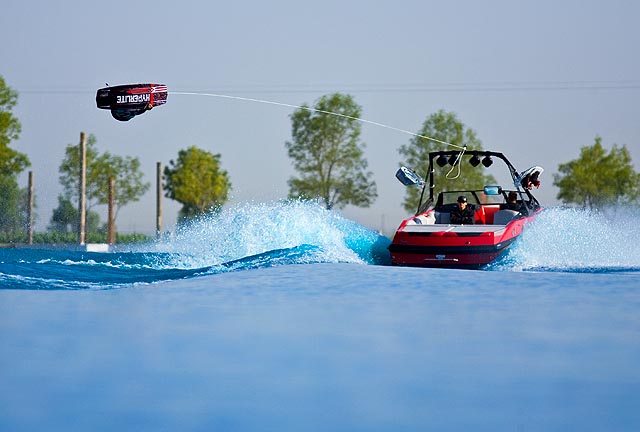
Shooting from the water can look cool, especially if you shoot with the camera right on top of the water. Jacob Valdez at the WSR Headquarters. ISO 200, 1/2500th @ f4.
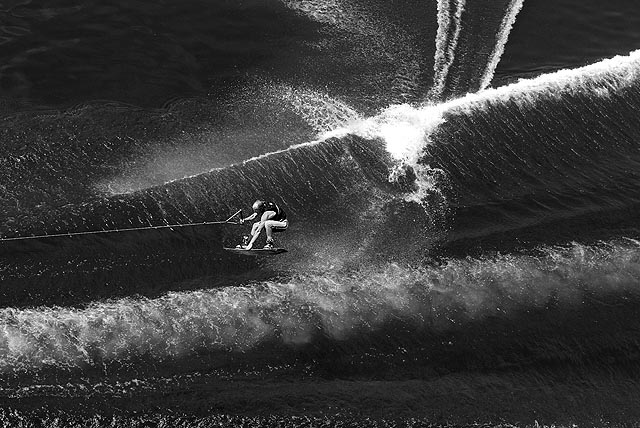
A helicopter is an awesome angle if you can ever find a way to shoot from one. Aaron Aubrey on Swan Lake, Montana. ISO 200, 1/2000th @ f4.
Stay tuned for the next couple parts of the Wake Photography 101 article that will talk about Composition and some Creative Techniques.
Part 1 of Wakeboarding Photography 101
The Alliance Photo Battle page
A cool video behind the scenes of a photo shoot with photographer Jason Lee
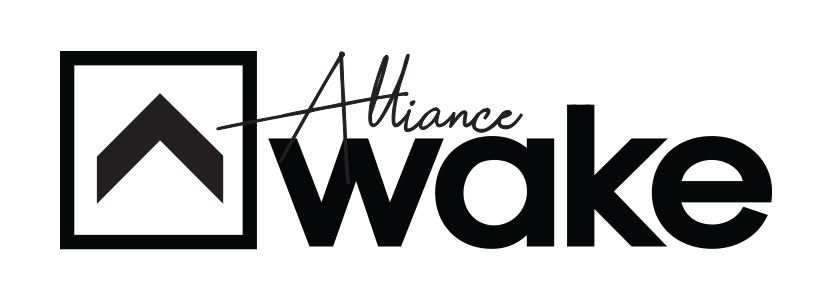

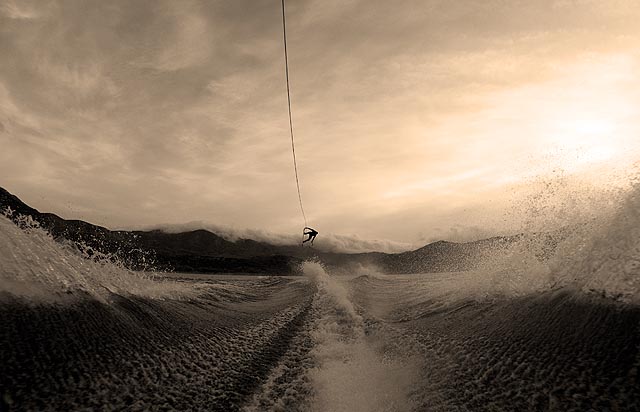
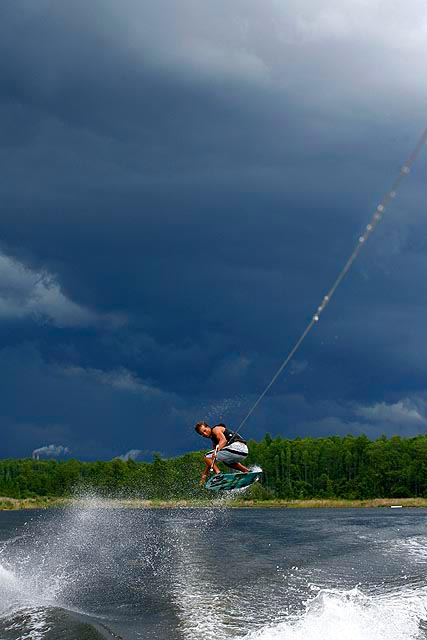
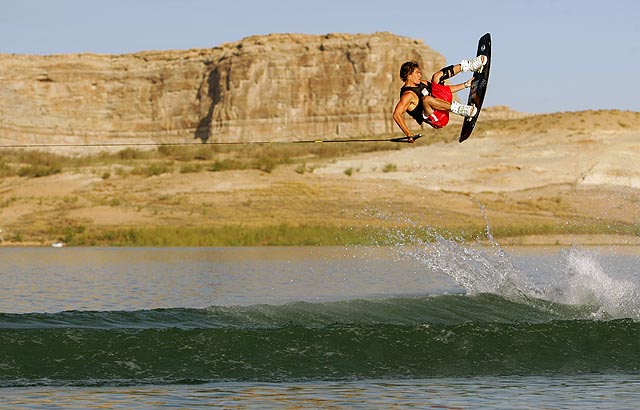
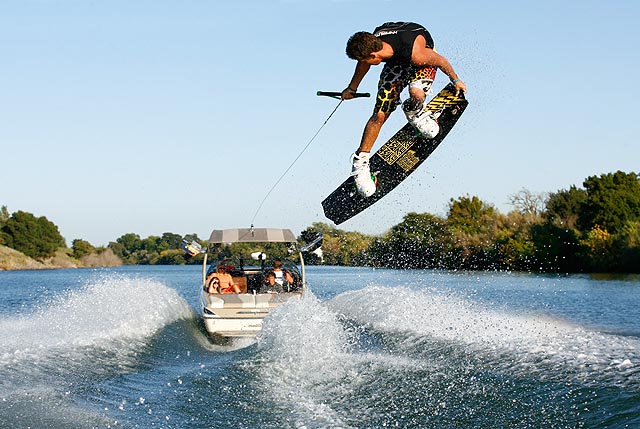
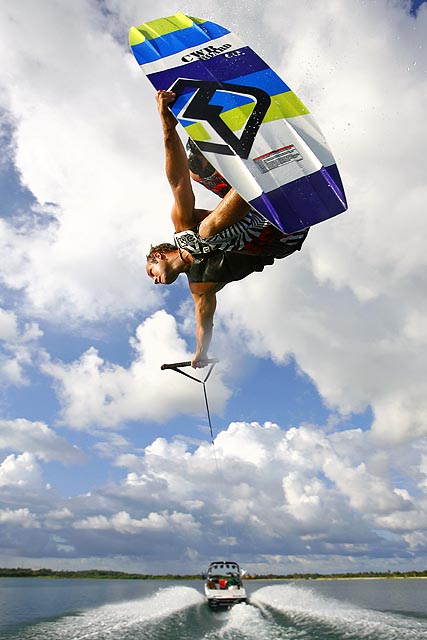





















December 16, 2009
"A helicopter is an awesome angle if you can ever find a way to shoot from one. "
no kidding, especially if you can get them to take the doors off so you are not shooting thru the windows.
December 17, 2009
I didn't see anything about focusing when not in the boat. From the boat, it's pretty easy to use auto-focus because the rider is always the same distance away. When shooting from a chaseboat, etc. do you use auto or manual focus?